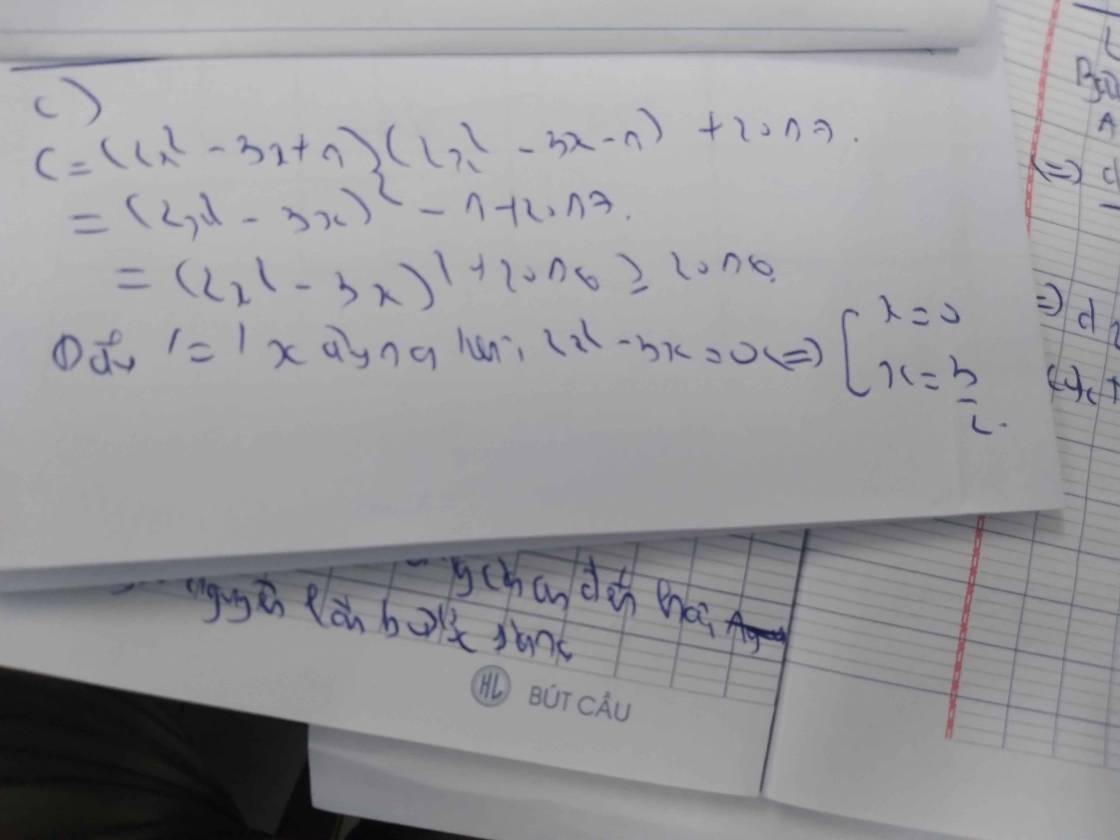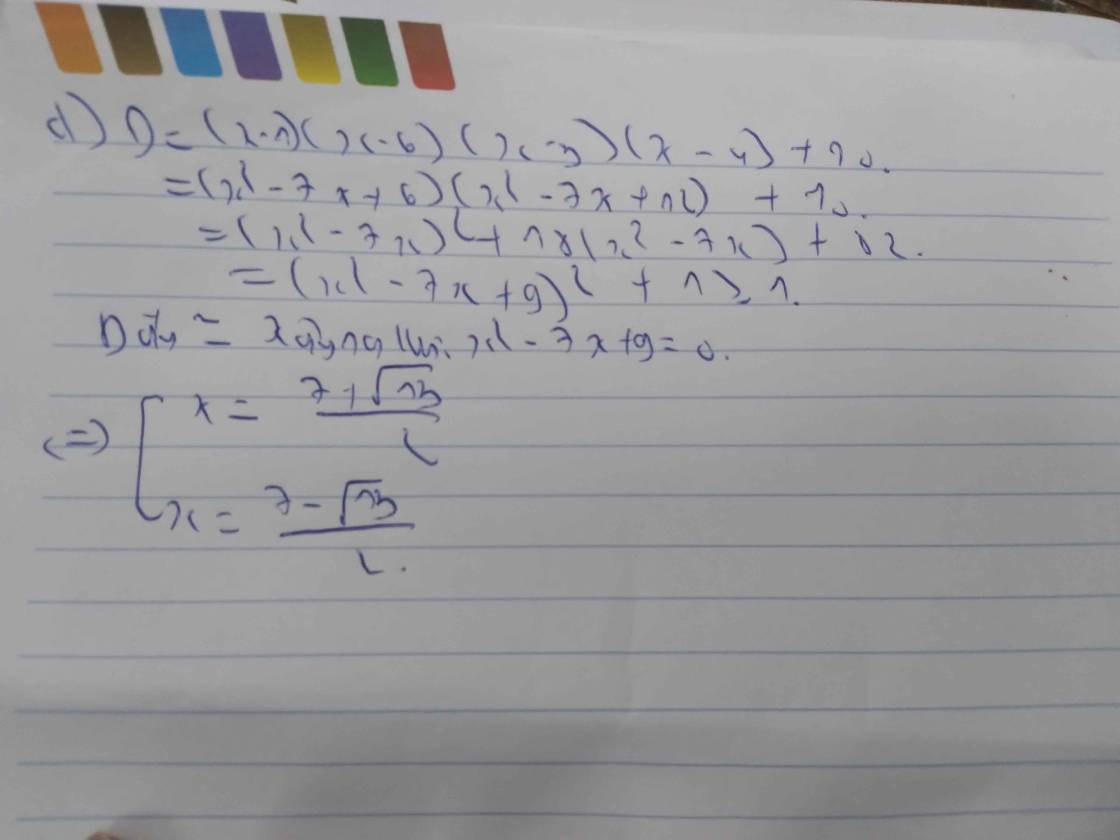Hãy nhập câu hỏi của bạn vào đây, nếu là tài khoản VIP, bạn sẽ được ưu tiên trả lời.

a,Ta có: \(x^3-4x^2-12x+27=x^3+3x^2-7x^2-21x+9x+27=x^2(x+3)-7x(x+3)+9(x+3)=(x+3)(x^2-7x+9)\)b,
\(25(x-y)^2-16(x+y)^2=(5x-5y+4x+4y)(5x-5y-4x-4y)=(9x-y)(x-9y)\)c,\(x^4+x^3+x+1=x^3(x+1)+(x+1)=(x^3+1)(x+1)=(x+1)^2(x^2-x+1)\)d, \(x(x+1)^2+x(x-5)-5(x+1)^2=(x+1)^2(x-5)+x(x-5)=(x-5)(x^2+3x+1)\)e,\(x^2-x-6=x^2-3x+2x-6=x(x-3)+2(x-3)=(x-3)(x+2)\)f,\(x^3-19x-30=x^3-5x^2+5x^2-25x+6x-30=(x-5)(x^2+5x+6)=(x-5)(x^2+2x+3x+6)=(x-5)(x+2)(x+3)\)
nãy bài 1 mk gửi thiếu 1 ý
\(x^2y+xy^2-x+y\)
có ai giúp mk ý này k
bài 2 thì k cần lm cũng đc nhé vì mk biết làm rùi còn mỗi ý này thui hu hu

Bài a) nhóm thành 2 nhóm; nhóm thứ nhất gồm số hạng đầu và cuối
bài b) dùng hằng đẳng thức là đc rồi

a) Ta có: \(C=\dfrac{x\left(1-x^2\right)^2}{1+x^2}:\left[\left(\dfrac{1-x^3}{1-x}+x\right)\left(\dfrac{1+x^3}{1+x}-x\right)\right]\)
\(=\dfrac{x\left(x^2-1\right)^2}{x^2+1}:\left[\left(\dfrac{\left(1-x\right)\left(1+x+x^2\right)}{1-x}+x\right)\left(\dfrac{\left(1+x\right)\left(1-x+x^2\right)}{\left(1+x\right)}-x\right)\right]\)
\(=\dfrac{x\left(x^2-1\right)^2}{x^2+1}:\left[\left(x^2+2x+1\right)\left(x^2-2x+1\right)\right]\)
\(=\dfrac{x\left(x-1\right)^2\cdot\left(x+1\right)^2}{\left(x^2+1\right)}\cdot\dfrac{1}{\left(x+1\right)^2\cdot\left(x-1\right)^2}\)
\(=\dfrac{x}{x^2+1}\)
b) Thay \(x=-\dfrac{3}{2}\) vào C, ta được:
\(C=\dfrac{-3}{2}:\left(\dfrac{9}{4}+1\right)=\dfrac{-3}{2}:\dfrac{13}{4}=\dfrac{-3}{2}\cdot\dfrac{4}{13}=\dfrac{-6}{13}\)
c) Ta có: \(C=\dfrac{1}{2}\)
nên \(\dfrac{x}{x^2+1}=\dfrac{1}{2}\)
\(\Leftrightarrow x^2-2x+1=0\)
\(\Leftrightarrow\left(x-1\right)^2=0\)
\(\Leftrightarrow x=1\)(Loại)

Bạn xem lại đề nhé.
a) \(A=x^2+5y^2+2xy-4x-8y+2015\)
\(A=x^2-4x+4-2y\left(x-2\right)+y^2+2011+4y^2\)
\(A=\left(x-2\right)^2-2y\left(x-2\right)+y^2+2011+4y^2\)
\(A=\left(x-2-y\right)^2+4y^2+2011\)
Vì \(\left(x-y-2\right)^2\ge0;4y^2\ge0\)
\(\Rightarrow A_{min}=2011\)
Dấu bằng xảy ra : \(\Leftrightarrow\left\{{}\begin{matrix}x-y-2=0\\4y^2=0\end{matrix}\right.\Leftrightarrow}\left\{{}\begin{matrix}x=2\\y=0\end{matrix}\right.\)

Bài làm:
Giả sử \(b>c\)
Với mọi \(x\)ta có \(\left(x+a\right)\left(x-4\right)-7=\left(x+b\right)\left(x+c\right)\left(1\right)\)
Với \(x=4\)ta được \(\left(x+b\right)\left(x+c\right)=\left(4+a\right)\cdot0-7=-7\)
Vì \(b,c\in Z\)và \(b>c\)và chúng đề có vai trò như nhau nên ta có hai trường hợp sau:
Trường hợp 1: \(\hept{\begin{cases}b+4=1\\c+4=-7\end{cases}\Rightarrow\hept{\begin{cases}b=-3\\c=-11\end{cases}}}\). Thay vào \(\left(1\right)\)ta được
\(\left(x+a\right)\left(x-4\right)-7=\left(x-3\right)\left(x-11\right)\)
\(\Leftrightarrow x^2+\left(a-4\right)\cdot x-\left(4a+7\right)=x^2-14x+33\)
\(\Leftrightarrow\left(a-4\right)\cdot x-\left(4a+7\right)=-14x+33\).
\(\Leftrightarrow a-4=-14\)và \(4a+7=-33\Leftrightarrow a=-10\)
Trường hợp 2: \(\hept{\begin{cases}b+4=7\\c+4=-1\end{cases}\Leftrightarrow\hept{\begin{cases}b=3\\c=-5\end{cases}}}\).Giải tương tự như trên ta được \(a=2\)
Vậy \(\orbr{\begin{cases}a=-10;b=-3;c=-11\\a=-10;b=-11;c=3\end{cases}}\)hoặc \(\orbr{\begin{cases}a=2;b=3;c=-5\\a=2;b=-5;c=3\end{cases}}\)
Bạn nhé khi mk giải thì mk chỉ có 2 trường hợp và ra kết quả a,b,c chỉ có hai nhưng khi mình kết luận mình đã kl đến 4 đáp số bởi vì như bạn đã đọc mk đã giả sử b>c nên cả trong hai trường hợp mk chỉ xét b>c thôi vd: ở trường hợp 1 mk chỉ xét b+4=1; c+4=-7 thì suy ra b=-3;c=-11 chứ mình không có xét th b+4=-7;c+4=1 nhé !
~~~~~~~~ GOOD LUCK ~~~~~~~~~~~~~~`

1. a) $(5-2x)^2-16=0$
$=>(5-2x)^2-4^2=0$
$=>(5-2x-4)(5-2x+4)=0$
$=>(1-2x)(9-2x)=0$
\(=>\left[{}\begin{matrix}1-2x=0=>x=0,5\\9-2x=0=>x=4,5\end{matrix}\right.\)
b) $x^2-4x=29$
$=>x^2-4x-29=0$
$=>(x^2-4x+4)-33=0$
$=>(x-2)^2-(\sqrt{33})^2=0$
$=>(x-2-\sqrt{33})(x-2+\sqrt{33})=0$
\(=>\left[{}\begin{matrix}x-2-\sqrt{33}=0=>x=\sqrt{33}+2\\x-2+\sqrt{33}=0=>x=2-\sqrt{33}\end{matrix}\right.\)
Bài 1:
a) \(\left(5-2x\right)^2-16=0\) (1)
\(\Leftrightarrow\left(5-2x\right)^2=16\)
\(\Leftrightarrow5-2x=\pm4\)
\(\Leftrightarrow\left[{}\begin{matrix}5-2x=4\\5-2x=-4\end{matrix}\right.\)
\(\Leftrightarrow\left[{}\begin{matrix}x=\dfrac{1}{2}\\x=\dfrac{9}{2}\end{matrix}\right.\)
Vậy tập nghiệm phương trình (1) là \(S=\left\{\dfrac{1}{2};\dfrac{9}{2}\right\}\)
b) \(x^2-4x=29\) (2)
\(\Leftrightarrow x^2-4x-29=0\)
\(\Leftrightarrow x=\dfrac{4\pm2\sqrt{33}}{2}\)
\(\Leftrightarrow\left[{}\begin{matrix}x=\dfrac{4+2\sqrt{33}}{2}\\x=\dfrac{4-2\sqrt{33}}{2}\end{matrix}\right.\)
\(\Leftrightarrow\left[{}\begin{matrix}x=2+\sqrt{33}\\x=2-\sqrt{33}\end{matrix}\right.\)
Vậy tập nghiệm phương trình (2) là \(S=\left\{2-\sqrt{33};2+\sqrt{33}\right\}\)
c) \(\left(x-3\right)^3-\left(x-3\right)\left(x^2+3x+9\right)+9\left(x+1\right)^2=15\) (3)
\(\Leftrightarrow x^3-9x^2+27x-27-\left(x^3-27\right)+9\left(x^2+2x+1\right)=15\)
\(\Leftrightarrow x^3-9x^2+27x-27-\left(x^3-27\right)+9x^2+18x+9=15\)
\(\Leftrightarrow x^3+27x-27-x^3+27+18x+9=15\)
\(\Leftrightarrow45x+9=15\)
\(\Leftrightarrow45x=15-9\)
\(\Leftrightarrow45x=6\)
\(\Leftrightarrow x=\dfrac{2}{15}\)
Vậy tập nghiệm phương trình (3) là \(S=\left\{\dfrac{2}{15}\right\}\)
d) \(2\left(x-5\right)\left(x+5\right)-\left(x+2\right)\left(2x-3\right)+x\left(x^2+8\right)=\left(x+1\right)\left(x^2-x+1\right)\)(4)
\(\Leftrightarrow2\left(x^2-25\right)-\left(2x^2-3x+4x-6\right)+x^3-8x=x^3+1\)
\(\Leftrightarrow2x^2-50-\left(2x^2+x-6\right)+x^3-8x=x^3+1\)
\(\Leftrightarrow2x^2-50-2x^2-x+6-8x=1\)
\(\Leftrightarrow-44-9x=1\)
\(\Leftrightarrow-9x=1+45\)
\(\Leftrightarrow-9x=45\)
\(\Leftrightarrow x=-5\)
Vậy tập nghiệm phương trình (4) là \(S=\left\{-5\right\}\)


Bài 1:
Ta có : \(\left(x^2-1\right)\left(x^2-4\right)\left(x^2-7\right)\left(x^2-10\right)< 0\)
\(\Leftrightarrow\left[\left(x^2-1\right)\left(x^2-10\right)\right].\left[\left(x^2-4\right)\left(x^2-7\right)\right]< 0\)
\(\Leftrightarrow\left(x^4-11x^2+10\right)\left(x^4-11x^2+28\right)< 0\)
Đặt \(y=x^4-11x^2+19\), ta có : \(\left(y-9\right)\left(y+9\right)< 0\)
\(\Leftrightarrow y^2< 81\Leftrightarrow-9< y< 9\) \(\Leftrightarrow\hept{\begin{cases}y>-9\left(1\right)\\y< 9\left(2\right)\end{cases}}\)
Giải (1) được : \(x^4-11x^2+28>0\) \(\Leftrightarrow\left(x^2-7\right)\left(x^2-4\right)>0\)
\(\Leftrightarrow\orbr{\begin{cases}x^2>7\\x^2< 4\end{cases}}\) \(\Leftrightarrow\orbr{\begin{cases}x>\sqrt{7}\\x< -\sqrt{7}\end{cases}}\)hoặc \(-2< x< 2\)
Giải (2) được :
\(\Leftrightarrow\hept{\begin{cases}x^2< 1\\x^2>10\end{cases}}\)(loại) hoặc \(1< x^2< 10\)(nhận)
\(\Rightarrow\hept{\begin{cases}x^2>1\\x^2< 10\end{cases}}\) \(\Leftrightarrow\orbr{\begin{cases}x< -1\\x>1\end{cases}}\)và \(-\sqrt{10}< x< \sqrt{10}\)
\(\Rightarrow\orbr{\begin{cases}-\sqrt{10}< x< -1\\1< x< \sqrt{10}\end{cases}}\)
Kết hợp (1) và (2) : \(-2< x< -1\);;\(1< x< 2\); \(\sqrt{7}< x< \sqrt{10}\); \(-\sqrt{10}< x< -\sqrt{7}\)
Suy ra các giá trị nguyên của x là : \(x\in\left\{-3;3\right\}\)
Bài 1:
Có: \(x^2-10< x^2-7< x^2-4< x^2-1\)
Để tích trên < 0
: \(\left(x^2-1\right);\left(x^2-4\right);\left(x^2-7\right)\)cùng dương và \(\left(x^2-10\right)\)âm
\(\Rightarrow x^2-10< 0\)và\(x^2-7>0\)
\(\Rightarrow x^2< 10\)và \(x^2>7\)
\(\Rightarrow7< x^2< 10\)
\(\Rightarrow x^2=9\Rightarrow x=+;-3\)